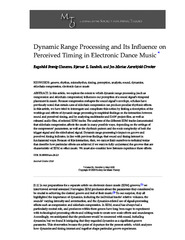| dc.contributor.author | Brøvig-Hanssen, Ragnhild | |
| dc.contributor.author | Sandvik, Bjørnar Ersland | |
| dc.contributor.author | Aareskjold-Drecker, Jon Marius | |
| dc.date.accessioned | 2020-09-22T11:45:01Z | |
| dc.date.available | 2020-09-22T11:45:01Z | |
| dc.date.issued | 2020-05 | |
| dc.description.abstract | In this article, we explore the extent to which dynamic range processing (such as compression and sidechain compression) influences our perception of a sound signal’s temporal placement in music. Because compression reshapes the sound signal’s envelope, scholars have previously noted that certain uses of sidechain compression can produce peculiar rhythmic effects. In this article, we have tried to interrogate and complicate this notion by linking a description of the workings and effects of dynamic range processing to empirical findings on the interaction between sound and perceived timing, and by analyzing multitracks and DAW project files, as well as released audio files, of selected EDM tracks. The analyses of the different EDM tracks demonstrated that sidechain compression affects the music in many possible ways, depending on the settings of the compressors’ parameters, as well as the rhythmic pattern and the sonic complexity of both the trigger signal and the sidechained signal. Dynamic range processing’s impact on groove and perceived timing indicates, in line with previous findings, that sound and timing interact in fundamental ways. Because of this interaction, then, we cannot limit ourselves to technical terms that describe how particular effects are achieved if we want to fully understand the grooves that are characteristic of EDM or other music. We must also consider how listeners experience these effects. | en_US |
| dc.identifier.citation | Brøvig-Hanssen R, Sandvik B, Aareskjold-Drecker JM. Dynamic Range Processing’s Influence on Perceived Timing in Electronic Dance Music. Music Theory Online. 2020;26(02) | en_US |
| dc.identifier.cristinID | FRIDAID 1829512 | |
| dc.identifier.doi | 10.30535/mto.26.2.3 | |
| dc.identifier.issn | 1067-3040 | |
| dc.identifier.uri | https://hdl.handle.net/10037/19456 | |
| dc.language.iso | eng | en_US |
| dc.publisher | Society for Music Theory | en_US |
| dc.relation.journal | Music Theory Online | |
| dc.relation.projectID | Norges forskningsråd: 249817 | en_US |
| dc.relation.projectID | Norges forskningsråd: 262762 | en_US |
| dc.relation.projectID | info:eu-repo/grantAgreement/RCN/FRIHUMSAM/249817/Norway/Timing and sound in musical microrhythm// | en_US |
| dc.relation.projectID | info:eu-repo/grantAgreement/RCN/SFF/262762/Norway/RITMO Centre for Interdisciplinary Studies in Rhythm, Time and Motion// | en_US |
| dc.rights.accessRights | openAccess | en_US |
| dc.rights.holder | Copyright © 2020 Society for Music Theory | en_US |
| dc.subject | VDP::Humanities: 000::Musicology: 110 | en_US |
| dc.subject | VDP::Humaniora: 000::Musikkvitenskap: 110 | en_US |
| dc.title | Dynamic Range Processing’s Influence on Perceived Timing in Electronic Dance Music | en_US |
| dc.type.version | publishedVersion | en_US |
| dc.type | Journal article | en_US |
| dc.type | Tidsskriftartikkel | en_US |
| dc.type | Peer reviewed | en_US |


 English
English norsk
norsk